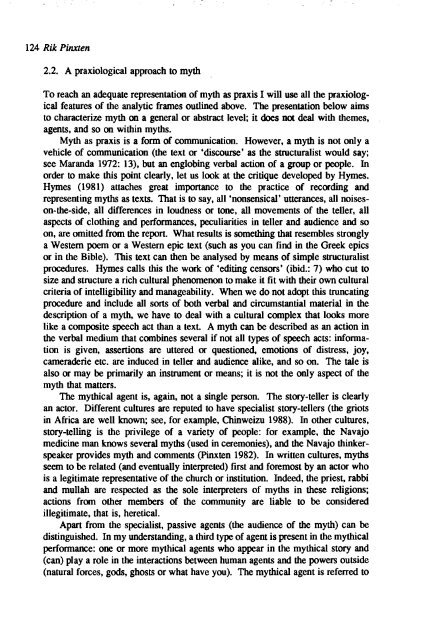1991 No. 1 CONTENTS - Institute of Social and Cultural ...
1991 No. 1 CONTENTS - Institute of Social and Cultural ...
1991 No. 1 CONTENTS - Institute of Social and Cultural ...
You also want an ePaper? Increase the reach of your titles
YUMPU automatically turns print PDFs into web optimized ePapers that Google loves.
124 Rik Pinxten<br />
2.2. A praxiological approach to myth<br />
To reach an adequate representation <strong>of</strong> myth as praxis I will use all the praxiological<br />
features <strong>of</strong> the analytic frames outlined above. The presentation below aims<br />
to characterize myth on a general or abstract level; it does not deal with themes,<br />
agents, <strong>and</strong> so on within myths.<br />
Myth as praxis is a form <strong>of</strong> communication. However, a myth is not only a<br />
vehicle <strong>of</strong> communication (the text or 'discourse' as the structuralist would say;<br />
see Mar<strong>and</strong>a 1972: 13), but an englobing verbal action <strong>of</strong> a group or people. In<br />
order to make this point clearly, let us look at the critique developed by Hymes.<br />
Hymes (1981) attaches great importance to the practice <strong>of</strong> recording <strong>and</strong><br />
representing myths as texts. That is to say, all 'nonsensical' utterances, all noiseson-the-side,<br />
all differences in loudness or tone, all movements <strong>of</strong> the teller, all<br />
aspects <strong>of</strong> clothing <strong>and</strong> performances, peculiarities in teller <strong>and</strong> audience <strong>and</strong> so<br />
on, are omitted from the report. What results is something that resembles strongly<br />
a Western poem or a Western epic text (such as you can find in the Greek epics<br />
or in the Bible). This text can then be analysed by means <strong>of</strong> simple structuralist<br />
procedures. Hymes calls this the work <strong>of</strong> 'editing censors' (ibid.: 7) who cut to<br />
size <strong>and</strong> structure a rich cultural phenomenon to make it fit with their own cultural<br />
criteria <strong>of</strong> intelligibility <strong>and</strong> manageability. When we do not adopt this b'uDcating<br />
procedure <strong>and</strong> include all sorts <strong>of</strong> both verbal <strong>and</strong> circumstantial material in the<br />
description <strong>of</strong> a myth, we have to deal with a cultural complex that looks more<br />
like a composite speech act than a text. A myth can be described as an action in<br />
the verbal medium that combines several if not all types <strong>of</strong> speech acts: information<br />
is given, assertions are uttered or questioned, emotions <strong>of</strong> distress, joy,<br />
cameraderie etc. are induced in teller <strong>and</strong> audience alike, <strong>and</strong> so 00. The tale is<br />
also or may be primarily an instrument or means; it is not the only aspect <strong>of</strong> the<br />
myth that matters.<br />
The mythical agent is, again, not a single person. The story-teller is clearly<br />
an actor. Different cultures are reputed to have specialist story-tellers (the griots<br />
in Africa are well known; see, for example, Chinweizu 1988). In other cultures,<br />
story-telling is the privilege <strong>of</strong> a variety <strong>of</strong> people: for example, the Navajo<br />
medicine man knows several myths (used in ceremonies), <strong>and</strong> the Navajo thinkerspeaker<br />
provides myth <strong>and</strong> comments (Pinxten 1982). In written cultures, myths<br />
seem to be related (<strong>and</strong> eventually interpreted) first <strong>and</strong> foremost by an actor who<br />
is a legitimate representative <strong>of</strong> the church or institution. Indeed, the priest, rabbi<br />
<strong>and</strong> mullah are respected as the sole interpreters <strong>of</strong> myths in these religions;<br />
actions from other members <strong>of</strong> the community are liable to be considered<br />
illegitimate, that is, heretical.<br />
Apart from the specialist, passive agents (the audience <strong>of</strong> the myth) can be<br />
distinguished. In my underst<strong>and</strong>ing, a third type <strong>of</strong> agent is present in the mythical<br />
performance: one or more mythical agents who appear in the mythical story <strong>and</strong><br />
(can) play a role in the interactions between human agents <strong>and</strong> the powers outside<br />
(natural forces, gods, ghosts or what have you). The mythical agent is referred to
















